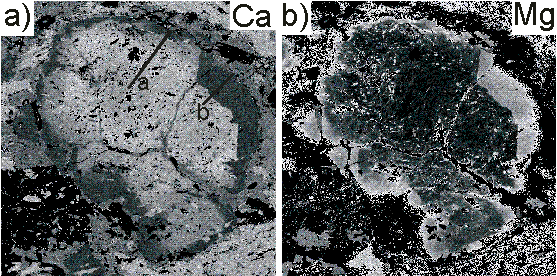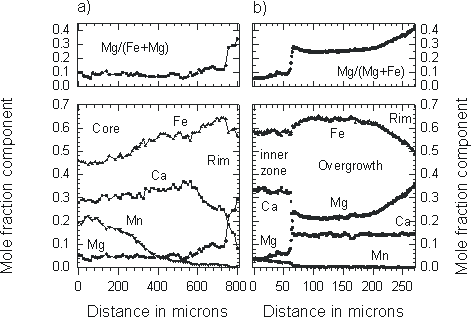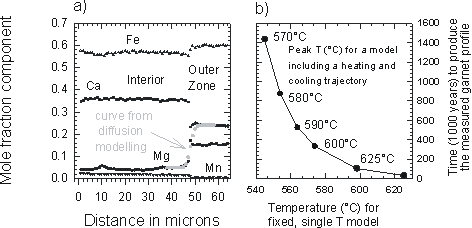

One of the most exciting research areas in metamorphic petrology in recent years has been the investigation of ultra-high pressure (UHP) rocks, containing minerals such as coesite and diamond. These rocks record subduction of the continental crust to depths of several hundred kilometers as well its subsequent exhumation such that metastable relics of the UHP mineralogy are still present. The documentation of the location, mineralogy and conditions of formation of these rocks has advanced tremendously in the last 10 years. A problem still unresolved, however, relates to the velocity of exhumation of these rocks such that they are not overprinted by lower grade assemblages. The fact that such UHP rocks occur in young mountain belts such as the Alps (35 Ma) or Himalaya (50-55 Ma) tells us immediately that the exhumation rate must be at least 2-3 mm/a. Geochronological methods can often bracket part of the pressure-temperature-time history but confirmation from another time-dependent method is often desirable. Here we present an example from the Indian Himalaya.
The investigated sample is an eclogite from the Tso Morari Massif of eastern Ladakh, India, and represents part of the Indian Plate deeply subducted during the Himalayan orogeny. In thin section, the garnets in this rock show a conspicuous boundary between inclusion-rich cores and inclusion-poor margins. Compositional mapping (Fig. 3.3-10) reveals that this textural contrast is also reflected in the major element chemistry with a very sharp compositional boundary occurring between the internal (inclusion-rich) and the external (inclusion-poor) zones. The magnitude of the compositional variation can be seen in the composition profiles plotted in Figure 3.3-11, for the profiles 'a' and 'b' located in Figure 3.3-10. Although the rim in profile A is much shorter than in B, both show cores that are Ca and Mn-rich and rims that are poorer in these elements, but with sharp increases in Mg and Fe. Profile B, in particular, shows a very sharp rise in Mg that is countered by an equally sharp fall in Ca. There is no doubt in these profiles that the outer zone of the garnet represents an overgrowth with a significantly different composition. Higher XMg at constant Ca in the overgrowth zone reflects growth at higher temperature. Thus this garnet has at least two growth stages preserved - each with their own specific zoning pattern.
The garnet composition is a result of initial growth at relatively low temperatures (core zone) followed by a second rim overgrowth stage at higher temperature and pressure conditions (peaking at ca. 550-600°C, 2.5 GPa). Examination of the entire rock reveals that following this was a distinct stage of high pressure fluid influx (blue amphibole and zoisite growth) and lower pressure amphibolite and greenschist facies stages. Partial resetting of the compositional step between the two garnet zones has occurred during this later thermal evolution, and by measuring the interdiffusion that took place between the two zones we can estimate the time duration of this thermal event. An interdiffusion model was applied at various temperatures and solved for time to fit the curve shown in Fig.3.3-11b. Diffusivities were determined for a range of temperatures (diffusion data from Chakraborty and Ganguly, Contrib, Mineral. Petrol., 111, 74-86, 1992), taking into consideration compositional dependence. The results are plotted in Figure 3.3-12. At 625°C, the peak of the amphibolite grade overprint, the recorded interdiffusion would have taken ca. 40000 years, and at 550°C, well below the peak temperature experienced, the interdiffusion would have taken 1.2 Ma. Taking a cooling path from a given peak temperature obviously increases the time required to produce the measured profile. When this is taken into consideration, however, the entire eclogite to greenschist evolution must have taken place within 3 Ma. This represents a phenomenally fast evolution of this section of subducted crust and is another contribution to the increasing volume of evidence pointing to unusually rapid tectonic events related to exhumation of deeply subducted continental material.
 |
 |
 |

Tel: +49-(0) 921 55 3700 / 3766, Fax: +49-(0) 921 55 3769, E-mail: bayerisches.geoinstitut(at)uni-bayreuth.de
 Previous page
Previous page